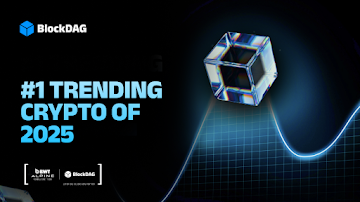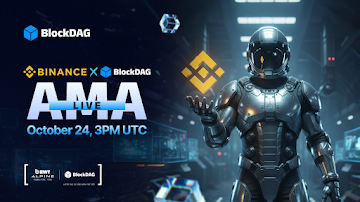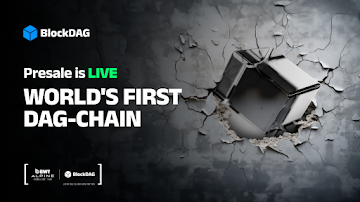When Bitcoin appeared in 2009, it introduced an entirely new concept of digital trust, a way to transfer value without intermediaries. A decade later, Solana emerged with a new benchmark: speed and throughput. Each solved a core problem of its time. Yet both left room for evolution. Bitcoin’s security came with trade-offs in scalability, while Solana’s speed often invited questions about decentralization and reliability.
Now, as the blockchain industry matures, a new architecture is emerging that aims to unify the strengths of its predecessors while addressing their weaknesses. BlockDAG, a project that has raised over $430 million in presale funding, claims to have built a hybrid model that combines Proof-of-Work’s resilience with Directed Acyclic Graph (DAG)-based scalability. If it works as designed, 2026 could be the year blockchain moves beyond the old trade-offs between speed, security, and decentralization.
A Shift in Blockchain Thinking
Traditional blockchains like Bitcoin and Ethereum process transactions sequentially, one block at a time. This design guarantees consistency but limits scalability. DAG networks, by contrast, allow multiple transactions and blocks to be processed in parallel, forming a graph rather than a chain. The result is faster validation and higher throughput without waiting for the “next block.”
BlockDAG’s approach bridges these two philosophies. It retains the Proof-of-Work (PoW) consensus model, still considered the gold standard for security and immutability, but implements it within a DAG framework. In simple terms, miners still perform work to validate transactions, but instead of competing for a single block, they can confirm multiple blocks simultaneously.
That subtle structural change carries major implications. In early testing, BlockDAG’s Awakening Testnet recorded speeds of 1,400 transactions per second (TPS), nearly double its previous iteration and far above the average of traditional PoW networks. Its architecture also supports theoretical scaling to 10,000+ TPS, rivaling Solana’s speed benchmarks while retaining the cryptographic integrity that Bitcoin pioneered.
The Architecture Behind the Claim
At the core of BlockDAG’s model is parallel block creation, where multiple miners can add verified transactions at once, without the need for a single “winning” block. Each block connects to several others, creating a web of validated transactions instead of a single chain.
The system’s anti-orphan mechanism ensures that no valid block is ever wasted, a major inefficiency in traditional mining networks. Every valid piece of work contributes to network finality, which means miners aren’t discarding energy or competing in a zero-sum fashion.
This not only increases efficiency but also changes the economics of mining. Miners, mobile users, and even developers can all participate meaningfully through BlockDAG’s Proof-of-Engagement layer, a system that rewards active participation in both validation and community building. With more than 3 million X1 mobile miners already engaged, it’s one of the most accessible PoW ecosystems in existence.
Compatibility Meets Accessibility
BlockDAG’s technical team also made a pragmatic choice that many early Layer-1s ignored: interoperability. The network is EVM-compatible, meaning developers from Ethereum can migrate or deploy smart contracts on BlockDAG with minimal friction.
The platform’s latest testnet includes support for account abstraction (EIP-4337), allowing smart wallets, gasless transactions, and multi-signature recovery, and an integrated IDE that lets users deploy ERC-20 tokens, mint NFTs, and test dApps directly. These features place BlockDAG in the same conversation as mainstream ecosystems like Avalanche or Polygon, but with a different architectural foundation.
Beyond speed and utility, the project’s testnet also integrates real-world metrics: live dashboards for TPS, gas usage, and miner activity. The inclusion of runtime upgradability ensures that future protocol improvements won’t require hard forks, another nod to forward-thinking design.
Timing and the Turning Point
Technology alone doesn’t create momentum; timing does. And BlockDAG’s timing couldn’t be more precise.
In an industry still recovering from cyclical volatility, the market’s appetite for credible, performance-driven networks has returned. Projects that combine transparent audits (BlockDAGs have been completed by CertiK and Halborn) with visible ecosystem growth tend to draw long-term investors rather than short-term speculators.
The upcoming Binance AMA on October 24 is expected to outline the project’s Genesis Day roadmap, a key inflection point where the presale era transitions into a live ecosystem. For many observers, it’s not just another marketing milestone; it’s a moment to assess whether BlockDAG can deliver at scale.
The Broader Picture: What a Hybrid Era Could Mean
If BlockDAG’s model proves viable, it could mark the beginning of a broader architectural shift. Just as Ethereum popularized smart contracts and Solana normalized sub-second transaction times, BlockDAG’s DAG-based Proof-of-Work could become a new standard for scalable security.
In broader terms, it hints at the next stage of blockchain evolution, networks that don’t force trade-offs between security, speed, and decentralization. The ability to merge Bitcoin’s trust model with Solana’s performance could attract institutional users, DeFi builders, and retail participants alike, bridging fragmented communities into a single high-performance ecosystem.
As 2026 approaches, crypto is entering a period of technological maturity. The wild experimentation of early DeFi and the speculative excess of meme cycles have given way to projects that prioritize performance, compliance, and sustainability. In that landscape, BlockDAG stands as a case study in synthesis, taking what worked, fixing what didn’t, and building for scale.
Presale: https://purchase.blockdag.network
Website: https://blockdag.network
Telegram: https://t.me/blockDAGnetworkOfficial
Discord: https://discord.gg/Q7BxghMVyu
Disclaimer: This is a paid post and should not be treated as news/advice. LiveBitcoinNews is not responsible for any loss or damage resulting from the content, products, or services referenced in this press release.





